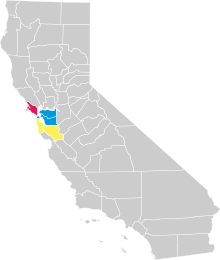Bay Area Rapid Transit District
The Bay Area Rapid Transit District, or BART, is a special-purpose district body that governs the Bay Area Rapid Transit system in the California counties of Alameda, Contra Costa and San Francisco. The system itself also serves northern San Mateo County and is being extended to Santa Clara County; however, these counties have bought into the system and have neither a voting stake nor any representatives in the district proper.[1]

| Part of a series of articles on |
History
The Bay Area Rapid Transit District (occasionally abbreviated in early years to BARTD) was created in 1957[2] to provide a transit alternative between suburbs in the East Bay and job centers in San Francisco's Financial District as well as (to a lesser extent) those in Downtown Oakland and Downtown Berkeley.
Of the six Bay Area counties initially envisioned as participants—San Francisco, Marin, Contra Costa, Alameda, San Mateo, and Santa Clara—only Santa Clara County refused to join when the district was first set up; it originally included both San Mateo and Marin Counties. San Mateo opted out in 1962, preferring to utilize funds to build its freeway and expressway system. Marin left a month after San Mateo, fearing that it would be unable to absorb its share of operating costs with San Mateo's withdrawal. Marin was also concerned by ongoing debate about the feasibility of running trains across a lower deck of the Golden Gate Bridge.
Structure
BART is split into nine districts, each of which elects one board member. One board member acts as president. Board members appoint five officers: General Manager, Controller-Treasurer, Independent Police Auditor, General Counsel, and District Secretary.
BART Board of Directors
Current board members, by district, include:
| District No. |
Board Member | County(s) | Stations |
|---|---|---|---|
| 1 | Debora Allen | Contra Costa | Concord, Lafayette, Pleasant Hill/Contra Costa Centre, Walnut Creek |
| 2 | Mark Foley | Contra Costa | North Concord/Martinez, Pittsburg/Bay Point |
| 3 | Rebecca Saltzman | Alameda / Contra Costa | Bay Fair, Downtown Berkeley, El Cerrito del Norte (partial), El Cerrito Plaza (partial), North Berkeley, Orinda, Rockridge, San Leandro |
| 4 | Robert Raburn | Alameda | Coliseum/Oakland Airport, Fruitvale, Lake Merritt, 12th Street/Oakland City Center, 19th Street/Oakland, MacArthur (partial) |
| 5 | John McPartland | Alameda | Castro Valley, Dublin/Pleasanton, Hayward, West Dublin/Pleasanton |
| 6 | Liz Ames | Alameda | Fremont, South Hayward, Union City |
| 7 | Lateefah Simon (President)[3] | Alameda / Contra Costa / San Francisco | Ashby, El Cerrito del Norte (partial), El Cerrito Plaza (partial), MacArthur (partial), Montgomery (partial), Richmond, West Oakland, Embarcadero (partial) |
| 8 | Janice Li | San Francisco | Balboa Park (partial), Embarcadero (partial), Montgomery (partial) |
| 9 | Bevan Dufty | San Francisco | 16th Street Mission, 24th Street Mission, Glen Park, Civic Center, Powell Street, Balboa Park (partial) |
Former BART Directors
- Carole Ward Allen, (1998-2010)[4]
- Lynette Sweet, (2003-2012)
- Dan Richards, (1992-2004)
- James Fang, (1990-2014)
- Margaret Pryor, (1980-1998)
- Willie B. Kennedy
- Bob Franklin, (2004-2012)
- Gail Murray, (2004-2016)
- Dan C. Helix[5]
- Zakhary Mallett, (2012-2016)
- Tom Radulovich, (1996-2016)
- Joel Keller, (1994-2018)
- Thomas Blalock, (1994-2018)
- Nick Josefowitz, (2014-2018)
References
- "San Francisco Bay Area Rapid Transit District". CalTransit.org. California Transit Association. Retrieved 30 May 2016.
- Simon, Lateefah. "Lateefah Simon". BART. BART. Retrieved 10 January 2020.
- "See a BART station, see a village". 28 September 2005. Retrieved 8 July 2017.
- Hoffmeister, Laura (29 November 2016). "ViewPoints by Laura Hoffmeister: Welcome, thanks for city council service". East Bay Times. Retrieved 6 December 2016.
